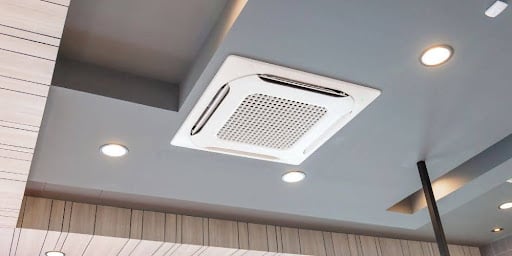
Centralized cooling systems like ducted split air conditioning systems give house-wide comfort. These systems use ductwork to distribute chilled air, eliminate hot spots, and maintain consistent temperatures.
Ducted split systems hide air handlers in the housing unit’s architecture, unlike traditional split air conditioning units requiring wall-mounted indoor units in every room. This space-saving design allows variable interior decorating while maintaining aesthetics.
Because noise-generating components are in the external unit, ducted split air conditioning systems operate quietly. Reduced noise creates a serene, comfortable living space without distractions.
Ducted split air conditioning systems use less energy than conventional ones. They use inverter technology and variable-speed compressors on their air conditioners. Precise temperature control and zoning optimize energy use, lowering electricity bills and environmental impact.
Covers application and versatility
The following are home and commercial uses for ducted split air conditioning systems:
Single-family homes, townhouses, and homeowners’ apartments Ducted split systems are ideal for residential properties since they cool the entire house without changing the interior.
Ducted split air conditioning systems can be tailored for commercial climate control. This allows the system to suit individual preferences and occupancy patterns.
Covers installation and maintenance
Ducted split air conditioning systems operate best and last longer with proper installation and maintenance. However, proper installation and maintenance are necessary to maximize ducted split air conditioning system performance and longevity. These systems offer complete residential and commercial temperature management. Let’s talk about building and maintaining ducted split air conditioning systems.
Installation process:
The installation process begins with a thorough investigation of the home or business’s size, layout, and cooling needs. Professionals evaluate insulation, ventilation, and ductwork to determine the best HVAC system layout.
Dimensions and planning:
Based on the assessment, HVAC AC Fixing professionals build ducting and choose air handlers and outdoor condensing units of the right size. The optimum dimensions ensure airflow and efficiency, preventing issues like inadequate cooling or excessive energy use.
Ductwork configuration:
Ductwork is needed to connect indoor air handlers to the outside condensing unit by routing air distribution channels through walls, ceilings, and floors. HVAC specialists seal connections and insulate ducts to reduce energy loss and maintain airflow.
Installation of Indoor Units After building the ducting, indoor air handlers are placed. Air handlers are commonly hidden in building ceilings or walls. Secure mounting and proper placement are essential for optimal circulation and even distribution of cooled air throughout the building.
The outdoor condensing unit is easily accessible outside the building and away from air-blocking obstacles. HVAC professionals ensure adequate clearance and grounding to maintain stability and ease maintenance.
The Refrigerator Line Connection:
The exterior condensing unit and internal air handlers are connected by refrigerant lines to transport heat and cool. HVAC experts carefully measure, cut, and seal refrigerant lines to reduce leaks and boost system performance.
Examination and Use:
HVAC technicians will thoroughly test and commission the system to verify its functionality, airflow balance, and refrigerant charge after installation. To maximize performance, any essential modifications or fine-tuning are done here.
Refrigeratant Inspection:
Periodic refrigerant tests are needed to detect and fix leaks, maintain system performance, and assure proper refrigerant levels. HVAC professionals utilize advanced technology to assess refrigerant pressure and replace or expel it.
Inspection of Ductwork:
To maintain airflow and reduce energy loss, check ductwork for leaks, corrosion, and inadequate insulation. HVAC technicians inspect ducting and utilize smoke tests and pressure gauges to diagnose problems.
Under Inspection: Electrical Components
HVAC specialists should undertake periodic professional servicing for more sophisticated maintenance projects and manufacturer warranty compliance. Professional air conditioning servicing includes detailed checks, adjustments, and performance optimization to maximize its lifespan.
Final remarks:
Ducted split air conditioning systems Fit out Company are popular for homes seeking comprehensive climate control because they combine efficiency, comfort, and versatility. These devices enhance interior aesthetics and cooling.
Frequently asked Questions
How do standard split AC units differ from ducted AC systems?
The indoor units of traditional split air conditioning units are visible and mounted on walls. However, ducted split systems hide air handlers in the home. This approach lets you decorate differently without ruining the space.
How does zoning affect ducted split AC?
Using ducted split air conditioning systems with zoning characteristics allows precise temperature control in different areas of a building. This function lets building managers and homeowners adjust temperatures to suit their needs and occupancy patterns.
Are ducted split air conditioners energy-efficient?
Ducted split air conditioning systems featuring inverter technology and variable-speed compressors are energy efficient. This is especially true for ducted systems. Precise temperature control and zoning optimize energy use, lowering electricity bills and environmental impact.
Can existing homes have ducted split air conditioning installed?
The home’s internal infrastructure and ducting space may determine whether ducted split air conditioning systems may be retrofitted into existing residences. HVAC experts can help you choose the best option.

